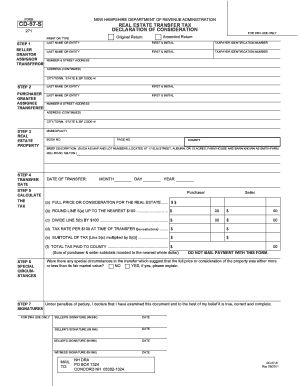Loading

Get Form Cd 57s
How it works
-
Open form follow the instructions
-
Easily sign the form with your finger
-
Send filled & signed form or save
How to fill out the Form Cd 57s online
The Form Cd 57s is crucial for declaring real estate transfer tax in New Hampshire. This guide will provide clear, step-by-step instructions to help users accurately complete the form online, ensuring compliance with state regulations.
Follow the steps to fill out the Form Cd 57s online effectively.
- Click ‘Get Form’ button to obtain the form and open it in the editor.
- Begin by entering the seller's information in Step 1. Provide the last name or entity, first name, initial, taxpayer identification number, and address of the seller, ensuring all details are accurate.
- Move on to Step 2 for the purchaser's information. Enter the full name or entity of the purchaser along with their first name, initial, taxpayer identification number, and address.
- In Step 3, provide details about the property being transferred. Include the municipality, book number, page number, and a brief description, such as map and lot numbers or the property address.
- Step 4 requires you to enter the date of transfer, ensuring it reflects the actual transaction date.
- Proceed to Step 5 for tax calculation. Accurately fill in the following fields: (a) the full price or consideration, (b) round the amount from (a) to the nearest $100, (c) divide the rounded amount by $100, (d) enter the tax rate applicable on the transfer date, (e) calculate the subtotal tax, and (f) sum the total tax paid.
- Step 6 addresses any special circumstances. Indicate if there were any special circumstances affecting the transfer's price, and provide explanations if necessary.
- In Step 7, sign the form in ink. Both the seller and purchaser must provide their signatures, dates, and a witness signature as required.
- After completing all sections, you can save changes, download, print, or share the form as needed.
Complete your Form Cd 57s online today to ensure a seamless real estate transaction.
Determine your realized amount. This is the sale price minus any commissions or fees paid. Subtract your basis (what you paid) from the realized amount (how much you sold it for) to determine the difference. If you sold your assets for more than you paid, you have a capital gain.
Industry-leading security and compliance
US Legal Forms protects your data by complying with industry-specific security standards.
-
In businnes since 199725+ years providing professional legal documents.
-
Accredited businessGuarantees that a business meets BBB accreditation standards in the US and Canada.
-
Secured by BraintreeValidated Level 1 PCI DSS compliant payment gateway that accepts most major credit and debit card brands from across the globe.


